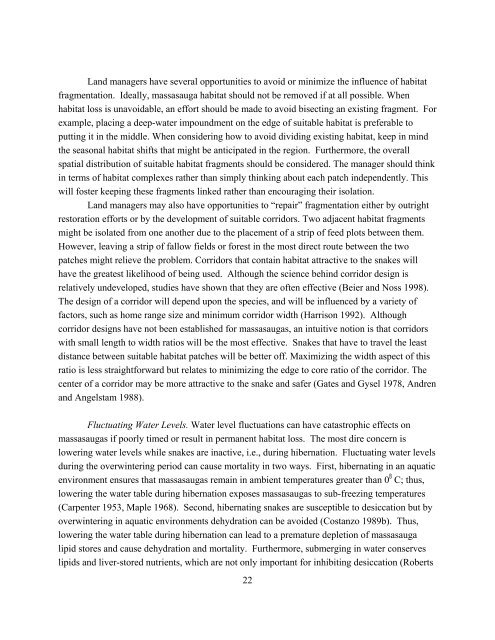The Eastern Massasauga Rattlesnake: - U.S. Fish and Wildlife Service
The Eastern Massasauga Rattlesnake: - U.S. Fish and Wildlife Service
The Eastern Massasauga Rattlesnake: - U.S. Fish and Wildlife Service
Create successful ePaper yourself
Turn your PDF publications into a flip-book with our unique Google optimized e-Paper software.
L<strong>and</strong> managers have several opportunities to avoid or minimize the influence of habitat<br />
fragmentation. Ideally, massasauga habitat should not be removed if at all possible. When<br />
habitat loss is unavoidable, an effort should be made to avoid bisecting an existing fragment. For<br />
example, placing a deep-water impoundment on the edge of suitable habitat is preferable to<br />
putting it in the middle. When considering how to avoid dividing existing habitat, keep in mind<br />
the seasonal habitat shifts that might be anticipated in the region. Furthermore, the overall<br />
spatial distribution of suitable habitat fragments should be considered. <strong>The</strong> manager should think<br />
in terms of habitat complexes rather than simply thinking about each patch independently. This<br />
will foster keeping these fragments linked rather than encouraging their isolation.<br />
L<strong>and</strong> managers may also have opportunities to “repair” fragmentation either by outright<br />
restoration efforts or by the development of suitable corridors. Two adjacent habitat fragments<br />
might be isolated from one another due to the placement of a strip of feed plots between them.<br />
However, leaving a strip of fallow fields or forest in the most direct route between the two<br />
patches might relieve the problem. Corridors that contain habitat attractive to the snakes will<br />
have the greatest likelihood of being used. Although the science behind corridor design is<br />
relatively undeveloped, studies have shown that they are often effective (Beier <strong>and</strong> Noss 1998).<br />
<strong>The</strong> design of a corridor will depend upon the species, <strong>and</strong> will be influenced by a variety of<br />
factors, such as home range size <strong>and</strong> minimum corridor width (Harrison 1992). Although<br />
corridor designs have not been established for massasaugas, an intuitive notion is that corridors<br />
with small length to width ratios will be the most effective. Snakes that have to travel the least<br />
distance between suitable habitat patches will be better off. Maximizing the width aspect of this<br />
ratio is less straightforward but relates to minimizing the edge to core ratio of the corridor. <strong>The</strong><br />
center of a corridor may be more attractive to the snake <strong>and</strong> safer (Gates <strong>and</strong> Gysel 1978, Andren<br />
<strong>and</strong> Angelstam 1988).<br />
Fluctuating Water Levels. Water level fluctuations can have catastrophic effects on<br />
massasaugas if poorly timed or result in permanent habitat loss. <strong>The</strong> most dire concern is<br />
lowering water levels while snakes are inactive, i.e., during hibernation. Fluctuating water levels<br />
during the overwintering period can cause mortality in two ways. First, hibernating in an aquatic<br />
environment ensures that massasaugas remain in ambient temperatures greater than 0 B C; thus,<br />
lowering the water table during hibernation exposes massasaugas to sub-freezing temperatures<br />
(Carpenter 1953, Maple 1968). Second, hibernating snakes are susceptible to desiccation but by<br />
overwintering in aquatic environments dehydration can be avoided (Costanzo 1989b). Thus,<br />
lowering the water table during hibernation can lead to a premature depletion of massasauga<br />
lipid stores <strong>and</strong> cause dehydration <strong>and</strong> mortality. Furthermore, submerging in water conserves<br />
lipids <strong>and</strong> liver-stored nutrients, which are not only important for inhibiting desiccation (Roberts<br />
22

















